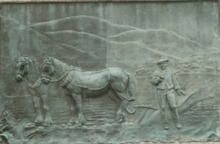To a Mountain Daisy
"To a Mountain Daisy", On Turning one Down, With The Plough, in April 1786 is a Scots poem written by Robert Burns in 1786. It was included in the Kilmarnock volume of Burns's poems, published in that year.[1]

The poem tells of how the poet, while out with the plough, discovers that he has crushed a daisy's stem. It is similar in some respects to his poem To a Mouse, published in the previous year. In ploughing a field in the early morning, there must have been hundreds of small flowers that were turned down by the plough and why Burns was taken with this particular specimen is a mystery.
In a similar way from To a Mouse, Burns compares the daisy's fate to that of humankind, first, in verse six, to a young girl taken in by her lover and then, in verse seven, to himself. The final stanza is in some ways reminiscent of Andrew Marvell's poem To His Coy Mistress:
But at my back I always hear
Time's wingèd chariot drawing near;
